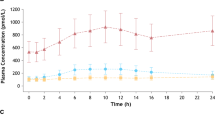Summary
The pharmacokinetic and pharmacodynamic interactions between metamizole (dipyrone) and furosemide were investigated in 9 of 12 healthy female subjects able to complete the study. They received oral metamizole 3×1 g for 3 days or placebo (cross-over) and on the last day of both study periods furosemide 20 mg IV. On the last two days a balanced sodium diet (120 mEq) and on Day 3 an oral water load (600 ml) were given. Metamizole significantly inhibited basal urine flow, whereas the fractional excretion of sodium and chloride and the 12 h-GFR remained unchanged. Metamizole significantly reduced furosemide clearance (175 vs 141 ml · min−1), furosemide-stimulated plasma renin activity (1.42 vs 0.79 ng AI · ml−1 · h−1) and the urinary excretion of prostacyclin metabolites and of prostaglandin F2α (by 70–81%). The renal clearance and terminal half-life of furosemide, peak renal chloride and volume excretion were unchanged. Thus, metamizole did not interact with the renal excretion and the diuretic effect of furosemide, although prostaglandin synthesis was significantly reduced.
Similar content being viewed by others
References
Brater DC (1983) Pharmacodynamic considerations in the use of diuretics. Ann Rev Pharmacol Toxicol 23: 45–62
Brenner BM, Meyer TW, Hostetter TH (1982) Dietary protein intake and the progressive nature of kidney disease: The role of hemodynamically mediated glomerular injury in the pathogenesis of progressive glomerular sclerosis in aging, renal ablation, and intrinsic renal disease. N Engl J Med 307: 652–659
Chennavasin P, Seiwell R, Brater DC (1980) Pharmacokinetic-dynamic analysis of the indomethacin-furosemide interaction in man. J Pharmacol Exp Ther 215: 77–81
Damm D (1989) Simultaneous determination of the main metabolites of dipyrone by HPLC. Arzneim-Forsch/Drug Res 39: 1415–1417
Daskalopoulos G, Kronborg I, Katkow W, Gonzalez M, Laffi G, Zipser RD (1985) Sulindac and indomethacin suppress the diuretic action of furosemide in patients with cirrhosis and ascites: evidence that sulindac affects renal prostaglandins. Am J Kidney Dis 6: 217–221
Dembinska-Kiec A, Zmuda A, Krupinska J (1976) Inhibition of prostaglandin synthetase by aspirin-like drugs in different microsomal preparations. In: Samuelsson B, Paoletti R (eds) Advances in Prostaglandin and Thromboxane Research 1, Raven Press, New York, pp 99–103
Eldor A, Polliack G, Vliodavsky I, Levy M (1983) Effects of dipyrone on prostaglandin production by human platelets and cultured bovine aortic endothelial cells. Thromb Haemostas 49: 132–137
Eldor A, Zylber-Katz E, Levy M (1984) The effect of oral administration of dipyrone on the capacity of blood platelets to synthesize thromboxane A2 in man. Eur J Clin Pharmacol 26: 171–176
Fejes-Tóth G, Magyar A, Walter J (1977) Renal response to vasopressin after inhibition of prostaglandin synthesis. Am J Physiol 232: F416-F423
Fine LG (1988) Preventing the progression of human renal disease: Have rational therapeutic principles emerged? Kidney Int 33: 116–128
Frölich JC, Hollifield JW, Dormois JC, Frölich BL, Seyberth H, Michelakis AM, Oates JA (1976) Suppression of plasma renin activity by indomethacin in man. Circ Res 39: 447–452
Frölich JC, Rupp WA, Zapf RM, Badian MJ (1986) The effects of metamizole on prostaglandin synthesis in man. In: Agents and actions supplements. 100 years of pyrazolone, Birkhäuser, Basel, pp 155–166
Hammarlund-Udenaes M, Benet LZ (1989) Furosemide pharmacokinetics and pharmacodynamics in health and disease — an update. J Pharmacokinet Biopharm 17: 1–46
Kahles H, Riegger AJG (1987) Indomethacin und Furosemid bei Patienten mit Herzinsuffizienz. Dtsch Med Wochenschr 112: 1737–1740
Kirchner KA (1985) Prostaglandin inhibitors alter loop segment chloride uptake during furosemide diuresis. Am J Physiol 248: F698-F704
Kirchner KA, Martin CJ, Bower JD (1986) Prostaglandin E2 but not I2 restores furosemide response in indomethacin-treated rats. Am J Physiol 250: F980-F985
Krishna GG, Newell G, Miller E, Heeger P, Smith R, Polansky M, Kapoor S, Hoeldtke R (1988) Protein-induced glomerular hyperfiltration: Role of hormonal factors. Kidney Int 33: 578–583
Mackert G, Reinke M, Schweer H, Seyberth HW (1989) Simultaneous determination of the primary prostanoids prostaglandin E2, prostaglandin F2α and 6-oxoprostaglandin F1α by immunoaffinity chromatography in combination with negative ion chemical ionization gas chromatography-tandem mass spectrometry. J Chromatogr 494: 13–22
Nies AS, Gal J, Fadul S, Gerber JG (1983) Indomethacin-furosemide interaction: the importance of renal blood flow. J Pharmacol Exp Ther 226: 27–32
Patrono C, Wennmalm A, Ciabattoni G, Nowak J, Pugliese F, Cinotti GA (1979) Evidence for an extra-renal origin of urinary prostaglandin E2 in healthy men. Prostaglandins 18: 623–629
Passmore AP, Copeland S, Johnston GD (1989) A comparison of the effects of ibuprofen and indomethacin upon renal haemodynamics and electrolyte excretion in the presence and absence of frusemide. Br J Clin Pharmacol 27: 483–490
Planas R, Arroyo V, Rimola A, Pérez-Ayuso RM, Rodés J (1983) Acetylsalicylic acid suppresses the renal hemodynamic effect and reduces the diuretic action of furosemide in cirrhosis with ascites. Gastroenterology 84: 247–252
Rosenkranz B, Fischer C, Weimer KE, Frölich JC (1980) Metabolism of prostacyclin and 6-keto-prostaglandin F1α in man. J Biol Chem 255: 10194–10198
Trautmann M, Peskar BM, Pritze S, Luck W, Hoppe U, Peskar BA (1989) Effects of metamizole and its metabolites on eicosanoid release from anaphylactic guinea pig lungs and rat gastric mucosa. In: Zor U, Naor Z, Danon A (eds) Leukotrienes and Prostanoids in Health and Disease. New Trends Lipid Mediators Res 3, Karger, Basel, pp 210–215
Vlahov V, Badian M, Verho M, Bacracheva N (1990) Pharmacokinetics of metamizole metabolites in healthy subjects after a single oral dose of metamizole sodium. Eur J Clin Pharmacol 38: 61–65
Weithmann KU, Alpermann HG (1985) Biochemical and pharmacological effects of dipyrone and its metabolites in model systems related to arachidonic acid cascade. Arzneim-Forsch/Drug Res 35: 947–952
Wilson DR, Honrath U, Sonnenberg H (1983) Furosemide action on collecting ducts: effect of prostaglandin synthesis inhibition. Am J Physiol 244: F666-F673
Author information
Authors and Affiliations
Rights and permissions
About this article
Cite this article
Rosenkranz, B., Lehr, K.H., Mackert, G. et al. Metamizole-furosemide interaction study in healthy volunteers. Eur J Clin Pharmacol 42, 593–598 (1992). https://doi.org/10.1007/BF00265921
Received:
Accepted:
Issue Date:
DOI: https://doi.org/10.1007/BF00265921




